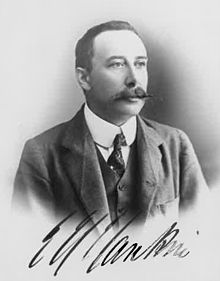Ernest Hanbury Hankin
| Ernest Hanbury Hankin | |
|---|---|

A Carte de visite portrait from the Cambridge Antiquarian Society collection (CAS H62) taken around 1900 at Agra.
|
|
| Born |
4 February 1865 Ware, Hertfordshire |
| Died | 29 March 1939 (aged 74) |
| Residence | India |
| Nationality | English |
| Fields |
Bacteriology Aeronautics Natural history Islamic geometric patterns |
| Known for | Bacteriophages |
Ernest Hanbury Hankin (4 February 1865 – 29 March 1939), was an English bacteriologist, aeronautical theorist and naturalist. Working mainly in India, he studied malaria, cholera and other diseases. He is often considered as among the first to detect bacteriophage activity and suggested that their presence in the waters of the Ganga and Jamuna rivers may have had a role in restricting the outbreaks of cholera. Apart from his professional studies, he took considerable interest in the Islamic geometric patterns in Mughal architecture ("Saracenic art" in the language of his day) as well as the soaring flight of birds, culture and its impact on education. He was sometimes criticized for being overzealous in his research methods.
Ernest Hankin was born in Ware, Hertfordshire, his father Rev. D. B. Hankin was later a Vicar of St Jude's, Mildmay Grove in North London. He was educated at Merchant Taylors' School from 1875 to 1882 and went to study medicine at St Bartholomew's Hospital Medical School and matriculated from St John's College, Cambridge in 1886. He was a Hutchinson Student and Scholar who passed with first class in both parts of the Natural Science Tripos in 1888 and 1889. He took a keen interest in bacteriology and decided against a career in medicine. In 1890 he was elected Hutchinson Student in Pathology and by the end of the year, he was admitted as a Fellow in November. He obtained the degree of MA in 1893 and Sc.D. in 1905 before working under Professor Charles Roy at his Pathological Laboratory in Trinity College London. His early studies in bacteriology included a new staining technique using aniline dyes (1886), some studies on anthrax in collaboration with F.F. Wesbrook, immunity and the role of "alexins". He worked under Robert Koch for some time in Berlin and under Louis Pasteur in Paris before he accepted a position in India as Chemical Examiner, Government Analyst and Bacteriologist for the United Provinces, Punjab and the Central Provinces and was posted at a laboratory in Agra in 1892.
...
Wikipedia
